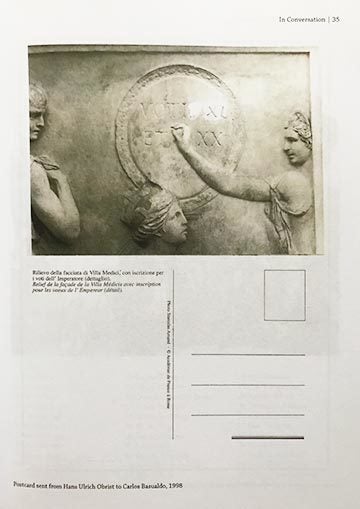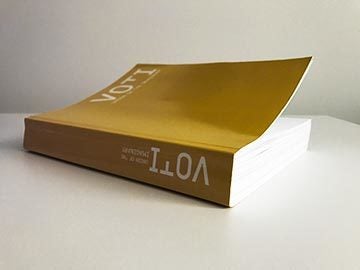
Postcard sent by Hans Ulrich Obrist to Carlos Basualdo, 1998 (VOTI: Union of the Imaginary, page 35)
Founded in 1998, VOTI: Union of the Imaginary was an online discussion forum for curators. A visionary idea to bring together curators from all over the world to freely discuss how the forces of globalization were impacting curatorial practice.
Founded by Carlos Basualdo, Hans Ulrich Obrist, and Jordan Crandall they were soon after joined by Susan Hapgood, Vasif Kortun and other independent thinkers.
This post summarizes the highlights of my conversations about VOTI, the online discussion forum, and about the recently published book that gathers hundreds of the email discussions from VOTI. With exceptional editing by Susan Hapgood, Vasif Kortun and November Paynter, this publication captures the spirit of the 1990s and includes conversations that are still relevant today.
Carlos Basualdo is the Keith L. and Katherine Sachs Curator of Contemporary Art, Philadelphia Museum of Art, Philadelphia.
Susan Hapgood is Executive Director of the International Studio & Curatorial Program (ISCP), New York.
Vasif Kortun was the founding Director of Research and Programs, SALT, Istanbul and Ankara.
Hans Ulrich Obrist is Co-director of Exhibitions and Programmes and Director of International Projects at the Serpentine Galleries, London.
November Paynter is Director of Programs, Museum of Contemporary Art Toronto Canada.
On the Motivation to Start VOTI
Carlos Basualdo: It was an interesting moment in time. I was working as an independent curator and there was some type of new consciousness of what it meant to be working as a curator. There was a rediscovery of the history of exhibitions and the curators of the 1960’s. Hans Ulrich and I felt that it would be great to have a group that would allow us to think about curatorial practice, and at the same time, try to defend the rights of curators, especially independent curators. So there was the ‘union’ aspect because we felt that independent curators were not being compensated or treated properly by institutions. But there was also the ‘playful’ aspect because both Hans Ulrich and I thought that VOTI would allow for the sharing of ideas and experimentation. I think that playfulness and imagination are essential when we are dealing with serious issues because it gives you permission to think openly, and not to confine yourself to a specific framework with which the art world ultimately confines you. It was about breaking the mold as much as possible. Both aspects, the union aspect and the imagination aspect were important for VOTI.
Hans Ulrich Obrist: VOTI was based on the idea of collegial collaboration. In 1998, Carlos Basualdo and myself felt that there was a growing homogenizing tendency imposed on curatorial activity and decided to organize a forum to resist this tendency. Later this year, we founded VOTI. At that time, it was also becoming clear that we needed to address the polyphony of art centers around the world. For me, it had to do a lot with the idea of mondialité proposed by Edouard Glissant, the writer, philosopher, and poet from Martinique. Very early on, Glissant understood that the force of globalization could lead to homogenization and to the disappearance of diversity, making things look similar all over the world. But he also understood that the counter-reaction to globalization will have negative implications. It could lead to new forms of nationalism and a lack of tolerance -and today, all over the world we are observing these counter-forces to globalization that lead to a refusal of the dialogue. So, VOTI was driven by this idea of mondialité because all of us in the 1990’s were part of a generation that wanted to have a more global dialogue. A dialogue that will not eliminate our identity but would change us and enrich our identity.
On the VOTI Conversations
Susan Hapgood: Waxing and waning, there were conversations pertaining to contemporary art, international curating, and actually a lot of political and humanitarian discussions. The dialogue could get really deep really fast. It was thrilling to have voices coming in from so many places. To be a part of this international dialogue with far-flung people who were in your profession was incredible.
Carlos Basualdo: Being an Argentinian, I was somewhat concerned about the participation of those who were not from major art centers, but they were super engaged. VOTI provided a different type of ground for different voices and it leveled up the hierarchies of the art world. So it is interesting to note that communication distance did not exist as a result of different nationalities or among curators of the center vs. curators of the periphery. It is also interesting to note that the biggest misunderstandings at the time were happening between independent curators and institutional curators. These two groups didn’t seem to speak the same language. They had different conceptions about what the practice is. When one speaks about curatorial practice, the context in which it takes place, the institutional context matters tremendously.
On Key VOTI themes
Susan Hapgood: Two key themes were developed around The Whitney Letter and The Economy of the Art World respectively. The Whitney Letter resulted in the first collective action by VOTI. Two of our respected colleagues had been suddenly fired from the Whitney Museum and we were all very upset about the lack of job security for curators around the world. So we united and wrote a letter to the director of the Whitney. This letter was signed by a long list of VOTI members and sent by fax repeatedly all day on December 1, 1998, from all over the world, creating a “fax jam” in the offices of the Whitney. Another lengthy conversation, entitled The Economy of the Art World aimed to address the roles of curators, contractual agreements and related issues of money and commitment. The points raised in The Economy of the Art World still hold today, where curators “may find themselves engulfed in corporate culture[s], marketed as stars, compensated for their expenses bot not their ideas,” as I wrote at the time.

VOTI: Union of the Imaginary
On VOTI the Book
Vasif Kortun: It was for years my dream to resurrect VOTI history. I'm happy that friends were very positive about it and it became a collective effort and SALT did the grunt work. VOTI comes from a time when curators were really in agonistic discussions with little if anything to lose. I'd returned to Turkey from the US in 1997 and the online discussion -during those dial up times- was one of my lifelines to colleagues. It gave us a sense of being part of a real and critical community. So I wanted to make VOTI part of history. I took up the resurrection task in 2010/11. Susan was great, as one of the founders she enabled it, gave it a great push. Robert Fleck's print archive of the email conversations was invaluable. And November Paynter came on board for editorial and secured permissions from the participants and we were somehow able to pull it altogether.
November Paynter: Each chapter in the book is preceded by a synopsis that provides readers with an access point into the conversation that follows. These introductions give the background, that is to say, a summary of how the conversations came about. They also give clear hints as to the peak moments of each discussion, such as the most important emails or key references.
On Conversations if VOTI Were Formed Today
Hans Ulrich Obrist: Here are some topics that I believe are of interest today.
(1) Transformation. The 2015 Marathon at Serpentine Galleries, for example, addressed cultural, political, and physical shifts. We were interested in how significant change can be achieved and for this purpose investigated the strategies of cyborgs, magicians, parasites, and storytellers to understand how to represent and effect change in the face of complexity.
(2) Extinction: In another Marathon project we focused on the specter of extinction that looms over the ways in which we understand our being in the world today - environmental degradation, atomic weapons, threats to communities and languages, global warming, economic collapses, disease and hunger are as urgent now as ever before.
(3) Digital Citizenship: In the 1990s the World Wide Web was a platform where people will freely navigate and we had this idea of a digital flâneur. Today, the idea of a digital citizenship has started to emerge. For the last couple of years, I’ve been involved with 89plus. It is a long-term, international, multi-platform research project co-founded with Simon Castets and we have been investigating the generation of artists born in or after 1989. The first generation that grew up with digital media, much more than the millennials. The year 1989 was the year of the introduction of the World Wide Web but also of the collapse of the Berlin Wall and the start of the post-Cold War period. One of the 89plus projects, Filter Bubble, reflects 89plus’s inquiry into the creative practices and influences of this generation by introducing a selection of pointed responses to the dilemma of blissful ignorance, paradoxically heightened by the pursuit of relevance in an ever-growing mass of data. A current project of 89plus is Americans 2017, an exhibition at the LUMA Westbau exhibition space in Zurich. It includes artists from around the world and aims to reconsider the notion of citizenship in light of its disruption by digital practices.
Susan Hapgood: I would add these topics for a new VOTI, in case other curators want to pick up where we left off:
(1) Curators unite to share strategies for amplifying contemporary art through digital channels.
(2) Address adequate job security measures and fair compensation for curators throughout the world. We never did write that contract for curators, but it would be helpful to lay out the areas of vulnerability, incorporating intellectual property and pay levels relative other (unfairly) higher paid professionals.
The transcribed text has been edited for length and clarity.
Lilia Ziamou is a visual artist. www.lilia-artspace.com
